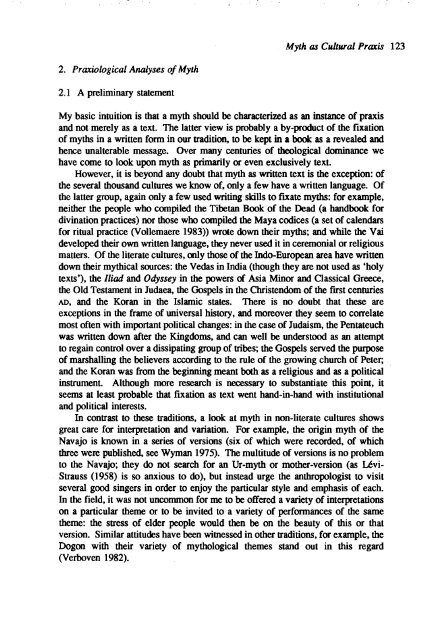1991 No. 1 CONTENTS - Institute of Social and Cultural ...
1991 No. 1 CONTENTS - Institute of Social and Cultural ...
1991 No. 1 CONTENTS - Institute of Social and Cultural ...
You also want an ePaper? Increase the reach of your titles
YUMPU automatically turns print PDFs into web optimized ePapers that Google loves.
Myth as <strong>Cultural</strong> Praxis 123<br />
2. Praxiological Analyses <strong>of</strong> Myth<br />
2.1 A preliminary statement<br />
My basic intuition is that a myth should be characterized as an instance <strong>of</strong> praxis<br />
<strong>and</strong> not merely as a text. The latter view is probably a by-product <strong>of</strong> the fixation<br />
<strong>of</strong> myths in a written form in our traditiont to be kept in a book as a revealed <strong>and</strong><br />
hence unalterable message. Over many centuries <strong>of</strong> theological dominance we<br />
have come to look upon myth as primarily or even exclusively text.<br />
However, it is beyond any doubt that myth as written text is the exception: <strong>of</strong><br />
the several thous<strong>and</strong> cultures we know <strong>of</strong>t only a few have a written language. Of<br />
the latter group, again only a few used writing skills to fixate myths: for example,<br />
neither the people who compiled the Tibetan Book <strong>of</strong> the Dead (a h<strong>and</strong>book for<br />
divination practices) nor those who compiled the Maya codices (a set <strong>of</strong> calendars<br />
for ritual practice (Vollemaere 1983» wrote down their myths; <strong>and</strong> while the Vai<br />
developed their own written language, they never used it in ceremonial or religious<br />
matters. Of the literate cultures, only those <strong>of</strong> the Indo-European area have written<br />
down their mythical sources: the Vedas in India (though they are not used as 'holy<br />
texts t), the Iliad <strong>and</strong> Odyssey in the powers <strong>of</strong> Asia Minor <strong>and</strong> Classical Greece,<br />
the Old Testament in Judaea, the Gospels in the Christendom <strong>of</strong> the fll'st centuries<br />
AD, <strong>and</strong> the Koran in the Islamic states. There is no doubt that these are<br />
exceptions in the frame <strong>of</strong> universal history, <strong>and</strong> moreover they seem to correlate<br />
most <strong>of</strong>ten with important political changes: in the case <strong>of</strong> Judaism, the Pentateuch<br />
was written down after the Kingdoms, <strong>and</strong> can well be understood as an attempt<br />
to regain control over a dissipating group <strong>of</strong> tribes; the Gospels served the purpose<br />
<strong>of</strong> marshalling the believers according to the rule <strong>of</strong> the growing church <strong>of</strong> Peter;<br />
<strong>and</strong> the Koran was from the beginning meant both as a religious <strong>and</strong> as a political<br />
instrument. Although more research is necessary to substantiate this point, it<br />
seems at least probable that fixation as text went h<strong>and</strong>-in-h<strong>and</strong> with institutional<br />
<strong>and</strong> political interests.<br />
In contrast to these traditions, a look at myth in non-literate cultures shows<br />
great care for interpretation <strong>and</strong> variation. For example, the origin myth <strong>of</strong> the<br />
Navajo is known in a series <strong>of</strong> versions (six <strong>of</strong> which were recorded, <strong>of</strong> which<br />
three were published, see Wyman 1975). The multitude <strong>of</strong> versions is no problem<br />
to the Navajo; they do not search for an Ur-myth or mother-version (as Uvi<br />
Straus8 (1958) is so anxious to do), but instead urge the anthropologist to visit<br />
several good singers in order to enjoy the particular style <strong>and</strong> emphasis <strong>of</strong> each.<br />
In the field, it was not uncommon for me to be <strong>of</strong>fered a variety <strong>of</strong> interpretations<br />
on a particular theme or to be invited to a variety <strong>of</strong> performances <strong>of</strong> the same<br />
theme: the stress <strong>of</strong> elder people would then be on the beauty <strong>of</strong> this or that<br />
version. Similar attitudes have been witnessed in other traditions, for example, the<br />
Dogon with their variety <strong>of</strong> mythological themes st<strong>and</strong> out in this regard<br />
(Verboven 1982).
















